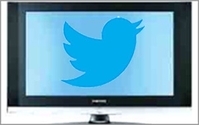
Nielsen says
adding deeper social media Twitter data to a new predictive TV program promotion model can help TV executives and advertising executives better determine which shows will succeed.
Using two
variables — promotion activity and Twitter activity — Nielsen's new model significantly improves the accuracy of whether a broadcast or cable show will succeed — 65% versus 48%.
Nielsen analyzed promotion activity and Twitter TV activity, along with network type (broadcast vs. cable), to gauge live plus seven days of time-shifted viewing among 18-34 audience sizes for 42
new series premieres from late August through early November.
The new model explained 65% of the “variance” in the premiere audience sizes — compared to 48% when looking at
on-air promos data. It didn’t disclose the identity of shows for the research.
Nielsen says a TV network or TV marketer could also have used this model to identify the top 10 and bottom
10 new series premieres rather than by relying on promotion data alone. With this knowledge, Nielsen believes TV marketers could more finely tune their media buys before the premieres — all due
to the inclusion of Twitter TV activity.
Nielsen does add a caution: “To be clear, the findings do not necessarily mean that Twitter TV activity causes larger audience sizes. But, even
if the relationship isn’t causal, our current and recent research efforts increasingly indicate that Twitter TV activity and reach data can help networks and agencies make superior, data-driven
advertising and program marketing decisions.”
In early 2013, Nielsen and Twitter started up a social media TV data service called Nielsen Twitter TV Ratings.